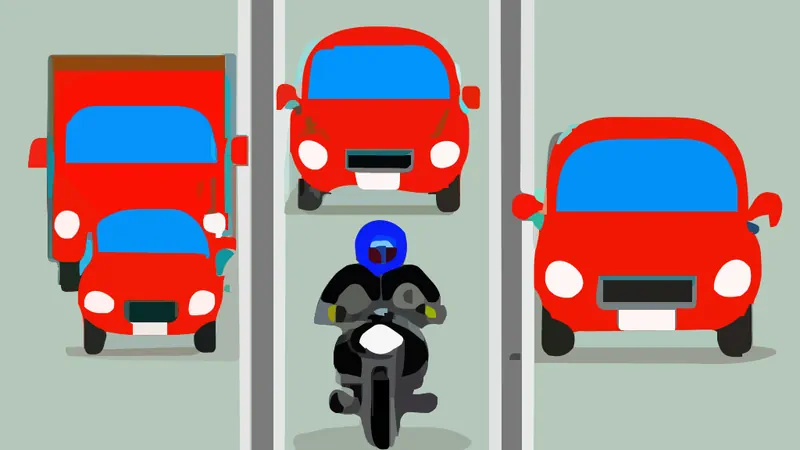In today’s current economic climate, increasing numbers of motorcyclists have been reported on Queensland roads. To alleviate further traffic congestion in built-up areas, several recent amendments to the Road Rules[1] have come into effect in Queensland. The new laws provide that:-
- Lane filtering is legal in certain circumstances, and
- Edge filtering is legal in certain circumstances.
Why Motorbike Riders Split Lanes & Edge Filter
When a motorcyclist filters through slow or stationary traffic to move forward, they are lane-splitting. Motorbike riders commonly execute this manoeuvre in an attempt to proceed through congested traffic whilst other motorists are stationary at a red light. Likewise, edge filtering is an exercise whereby a motorcyclist ‘filters’ along the edge of slow or stationary traffic in circumstances where the relevant speed limits are over 90 km/h.
In Queensland, edge filtering is only permitted on high-speed roads, like highways, because they do not present additional risks from parked cars, pedestrians, cyclists, and driveways.
QLD Motorcycle Lane Filtering Laws
Under the new laws[2], motorcyclists may lane filter if, and only when:-
- They have an open license;
- They do not travel faster than 30 km/h;
- They are not in a school zone; and
- It is safe to do so.
Similarly, motorcyclists’ may edge filter[3] in circumstances where:-
They have an open license;
- The speed limit is 90 km/h or more;
- They do not travel faster than 30 km/h;
- They do not ride on any unsealed part of the road; and
- It is safe to do so.
The new laws do not presume that motorcyclists’ when engaging in filtering, are afforded particular privileges or right of way. Motorbike riders may only engage in such practices when it is safe to do so in the circumstances they are presented.
Given the rationale behind the new laws and the inherent dangers involved in executing such conduct, it would be prudent to review the subtle nuances regarding liability and potential claims for damages.
Motorbike Accident Case Study: Goreski v de Costa
The recent Supreme Court decision of Chief Justice Murrell in Goreski v de Costa[4] articulates an example of circumstances where a motorcyclist breached their duty of care.
In that matter, a motorcyclist (“the Appellant”) heading east on Canberra Avenue approached a congested intersection that was governed by a red light. The Appellant slowed to approximately 40 km/h and proceeded forward alongside the stationary traffic via a designated lane for cyclists. Immediately before reaching the intersection, the traffic lights illuminated green, and the Appellant accelerated to 80 km/h. The Appellant’s fast acceleration allowed him to merge into kerb side left lane in front of the aforementioned stationary traffic. Notably, the relevant speed limit was 90 km/h.
The driver of the third-party motor vehicle (“the Respondent”) approached the relevant intersection from the north intending to execute a left-hand turn onto Canberra Avenue – into the path of the Appellant. The Respondent was governed by a ‘give way’ sign, which required him to give way to all traffic already on Canberra Avenue.
The Respondent looked to his right twice, noting the other motorists at the lights, before entering Canberra Avenue at low speed. As the Respondent’s motor vehicle entered Canberra Avenue, he was struck by the accelerating Appellant, who impacted the front driver’s side of his vehicle.
What was the Decision?
In the primary judge’s decision, her honour made reference to the decision of Sibley v Kais[5], wherein it was held that a breach of traffic law does not establish that a motorist has acted negligently. Her honour went further to say that in determining whether there has been a breach of the common law duty of care, a Court must have regard to all of the circumstances.
In the relevant circumstances, although the Respondent had failed to give way to the Appellant, which was a requirement of entry onto Canberra Avenue, he had, on the balance of probabilities, executed all that a reasonably prudent driver in the same position, who was keeping a proper lookout, could be expected to do.
Her honour held that the Appellant:-
- Travelled too fast for the circumstances;
- Failed to keep a proper lookout; and
- Failed to take appropriate precautions for his safety and, by doing so, put other road users at risk.
The Theory Behind The Decision
Ultimately, every driver that approaches an intersection, regardless of whether or not they are presented with a “give way” sign, must take reasonable care and to have the capacity to be able to avoid a collision if the circumstances so arise.
The degree and extent of a Court’s allowance for unexpected behaviour by road users will depend on the degree of risk in the particular circumstances. Occasionally, there will be competing risks, such as traffic lights, slip lanes and zebra crossings. When there are competing demands on a driver’s concentration, it is imperative that every one of these risks are carefully weighed and considered.
It goes without saying that motorcyclists are injured in accidents because they are among the most vulnerable of all road users in Queensland due largely to the limited protection available. Motorbike riders must take appropriate precautions for their safety, particularly when utilising the new amendments to the Road Rules.
Time Limits for Motor Vehicle Accident Claims
Strict time limitations are enforced in Queensland for motor vehicle claims. If you or someone you know has been injured on a Queensland road, take the responsible approach and telephone Splatt Lawyers today at 1800 954 153 for an obligation-free consultation.
[1] Transport Operations (Road Use Management – Road Rules ) Regulation (2009)
[2] Section 151A Transport Operations (Road Use Management – Road Rules ) Regulation (2009)
[3] Section 151B Transport Operations (Road Use Management – Road Rules ) Regulation (2009)
[4] Goreski v de Costa [2014] ACTSC 23
[5] Sibley v Kais (1967) 118 CLR 428
More about CTP claim time limits >
Motorcycle Accident Lawyers Near You
Choose your location now:
